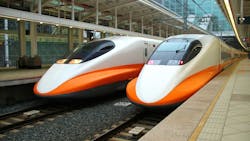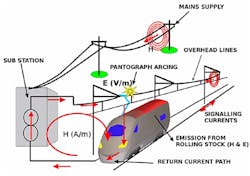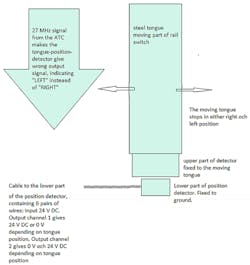Controlling EMI in Railway Systems
This article is part of the TechXchange: Delving into EMI, EMC and Noise
Members can download this article in PDF format.
What you'll learn:
- How does EMI impact railway equipment and systems?
- What types of railway equipment are most affected?
- Potential safety concerns and hazardous events.
Modern railway systems are experiencing increasing traffic, higher speeds, longer trains, heavier axle loads, and more trains per hour. This trend needs more powerful engines with more powerful currents flowing through electrical power lines.
More and more increasingly complex electronic systems are finding their way into modern railway systems. The railway track environment can be constantly exposed to magnetic and electric fields from trains, nearby electric transmission power lines, switches, and more. This leads to an increase in radiated and conducted EMI. More modernized railway systems with sensitive electronic circuitry are becoming more susceptible to increased electromagnetic noise at higher frequencies.
Traffic Signals
Safety and efficiency are improved with better traffic signal designs. An example is that all lights will go from green to red in the event of any possible errors in the signaling system. Electromagnetic compatibility (EMC) can include inductive noise in parallel communication lines, impulse noise from lightning and traction transients, the production of hazardous voltage under step and touch conditions, and the appearance of stray currents (Fig. 1).
Traffic signals tend to be reliable; however, there have been unexplained incidents possibly caused by passing train disturbances. Designers are working to improve and minimize these occurrences.
Rolling Stock
Safe and allowable EMI from the railway to the outside world are clearly defined by industry standards. One example is EN 50121-2, which provides guidance for maximum emission levels that can be measured at the railway boundary fence. Induced ground currents, from environmental magnetic or electric fields, can’t be neglected in the railway sector, since amplitudes are powerful enough to affect surrounding facilities, including buildings, houses, and other areas.
EMI in Signal Systems
Shuttle train problems have cropped up with certain signals along the track. A train control center (TCC) discovered that there was interference in the train control system circuitry when multiple trains were occupying the same track in the station. An affected signal switched to red several times just in front of the train, and that train had to make a brake-intensive emergency stop. After a brief time, the signal’s indications switched off again.
On the affected train, such interference could show as a balise fault. A further study determined that an insulated section of track was situated 475 meters from the electrical cabinet that controlled the faulty signal and was 430 meters from where the cables entered that signal.
It turned out that a transient electromagnetic field occurred when the train driver left the neutral section of the overhead power line and entered the powered section. What happened was a nearby locomotive had started and was identified as the main source of EMI that affected the signal system. The transient EMI field produced at that time caused the interference.
To prevent this kind of interference, the solution would be to connect the overhead line (OHL) and the insulated portion of the track to the power system and energize it. This would prevent the random stops and starts of the locomotive and prevent any EMI field occurrences.
Automatic Train Control (ATC) EMI on Track Switch Detectors
Train safety of course is a top priority, and designers need to pay attention to devices that improve safety but also may be affected by EMI. Examples include switches and crosses, susceptible to EMI, that decide different paths for trains to avoid collision with other rolling stock on a closed track.
EMI may cause a rail switch position to indicate “LEFT” instead of “RIGHT” from an ATC signal from another passing train (Fig. 2). These track switch detectors can be sensitive to radio frequencies in the dc-to-300-MHz ranges, especially from ATC radio transmitters located beneath the front of the lead locomotive in a passing train.
The solution here is to do some EMC testing on these devices before installing them.
EMI Effect on Train BCU Speed Sensors
It’s been found that on high-speed trains (HSTs), the fluctuating voltage between a train body (TB) and the train wheel axis can cause EMI on the brake control unit (BCU) speed sensor on HSTs. This occurrence may cause improper measurement of the train speed as well as problems in the train door operation.
The BCU has a highly accurate measurement accuracy and an excellent performance in the presence of interferences such as vibration, pressure, and temperature. However, the BCU speed sensor still does experience some EMI issues.
One example involved a train door that would not open normally when the train was in the station and ready to depart. The fault was caused by EMI on the BCU speed sensor, which may have been related to voltage changes between the TB and the train wheel axis.
Summary
This article highlighted some major issues regarding EMI and looked at many of the most important safety concerns and potential hazardous events caused by EMI in the railway system. Signal systems, automated train control, and BCU speed sensors are typically the most likely areas to be impacted by EMI events.
Some of the largest railways are in China, U.S., and Europe. Europe claims to be the safest in the world; the European Union (EU) is striving to maintain high standards and harmonize safety requirements EU-wide. The EU also seeks to ensure interoperability of national railway systems. EU legislation sets the framework for a harmonized approach to rail safety throughout the region. China restructured their railways in 2013. The country is looking at Evolutionary Game Theory and System Dynamics to make their railways safer. And the U.S. Department of Transportation promotes and regulates safety throughout the nation’s railroad industry.
Read more articles in the TechXchange: Delving into EMI, EMC and Noise
References
- Railway EMI impact on train operation and environment
- Modeling and Simulation on Overall-train EMI of China Standardized High-speed Train
- Evaluation Scheme for EMI of Train Body Voltage Fluctuation on the BCU Speed Sensor Measurement
- Electromagnetic interference characteristics and countermeasures on subway train
- Design and Analysis of EMI Shielding Method using Intermediate Coil for Train WPT System


